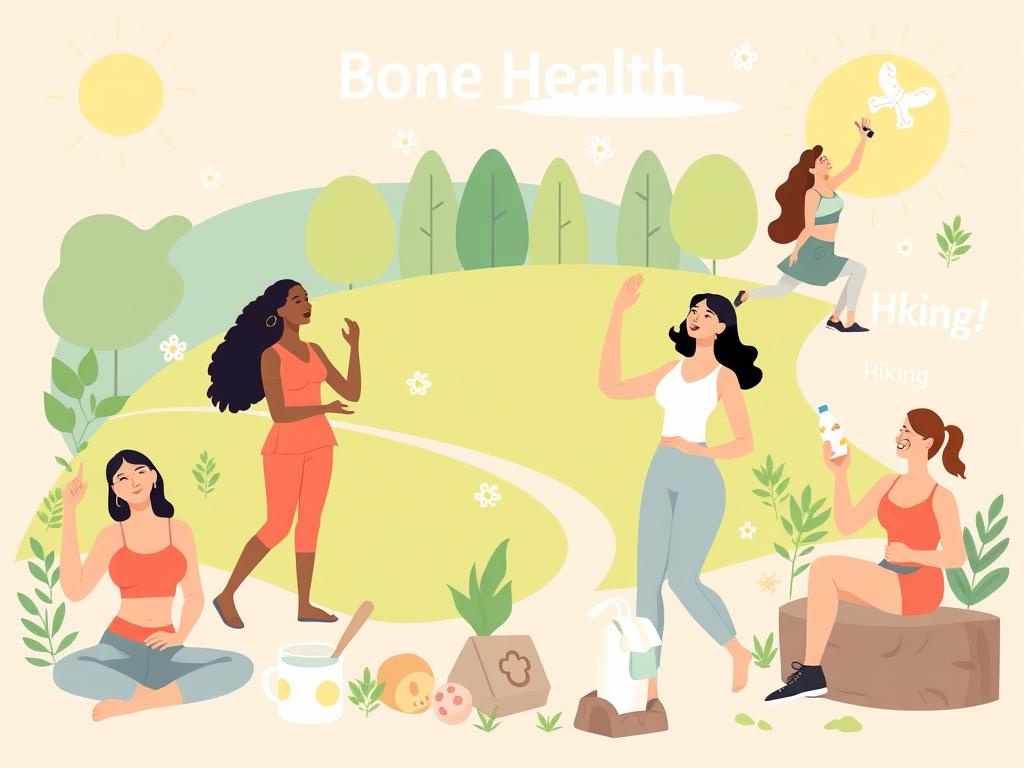Did you know that approximately 54 million Americans are estimated to have osteoporosis or low bone mass? This staggering statistic underscores the importance of maintaining strong bones, especially for women who are at greater risk due to having less bone tissue than men. Understanding how to maintain bone health is crucial across all ages, as women experience significant hormonal changes that can affect bone density, especially during menopause.
In this article, we will explore essential tips for women of all ages to enhance bone health and prevent osteoporosis. From a calcium-rich diet to the right types of exercise, understanding your body’s needs is vital for preserving bone structure and function. Starting these healthy habits early can lead to a stronger, more resilient skeleton in the future.
Key Takeaways
- Women can significantly decrease their risk of osteoporosis through early lifestyle choices.
- Calcium and Vitamin D are essential nutrients for maintaining bone density.
- Regular weight-bearing exercise strengthens bones and reduces bone loss.
- Avoiding smoking and limiting alcohol can greatly improve bone health.
- Regular bone density screenings help detect issues early, providing a roadmap for bone health management.
Understanding Bone Health and Its Importance
Maintaining optimal women’s bone health is critical for overall well-being throughout life. Strong bones support daily activities and reduce injury risks. A deep understanding of the factors contributing to bone density maintenance is essential, especially when considering the long-term implications associated with poor bone health.
The Role of Calcium in Bone Density
Calcium serves as a key building block for bones. It plays a vital role in bone density maintenance by helping to form and preserve bone tissue. Women should aim for the Recommended Dietary Allowance (RDA) of calcium, which is 1,200 mg daily for those aged 51 and older. Inadequate calcium intake can increase the risks of poor bone health, leading to conditions like osteoporosis, which affects millions of Americans each year.
Benefits of Bone Health for Women
Healthy bones contribute significantly to structural support and protection of internal organs. They also improve mobility, enhancing overall quality of life. Strong bones enable women to engage in a variety of activities without discomfort, promoting an active lifestyle that supports both physical and mental health. Incorporating a balanced diet rich in nutrients further strengthens bone tissue.
Risks of Poor Bone Health Across Lifespan
The risks of poor bone health escalate with age, particularly after menopause when women can lose up to 20% of their bone density. Osteoporosis is a significant concern, affecting one in two women over the age of 50. This condition can lead to approximately two million broken bones annually. Additional risk factors include inadequate estrogen levels, unhealthy lifestyle choices, and failure to achieve peak bone mass during younger years, emphasizing the importance of consistent bone care.

Nutrients Essential for Strong Bones
Ensuring healthy bones for women requires a multifaceted approach, focusing on vital nutrients that support bone structure and strength. Essential minerals and vitamins, particularly calcium and vitamin D, play key roles in maintaining bone density and overall bone health. Incorporating these nutrients effectively into daily diets can help prevent osteoporosis and fractures, especially in women over the age of 50. Below, we explore the essential nutrients and their sources to keep bones strong and healthy.
Calcium-Rich Foods to Incorporate
Calcium is crucial for building and maintaining healthy bones. Aiming for adequate calcium intake through diet is vital, as it can significantly impact women’s bone health at various life stages. Some of the best sources of calcium-rich foods include:
- Milk and dairy products (low-fat options are recommended)
- Green leafy vegetables (e.g., kale, collard greens)
- Canned fish with bones (such as salmon and sardines)
- Nuts and seeds (especially almonds and sesame seeds)
- Legumes (like beans and lentils)
Women under 50 should aim for 1,000 mg of calcium daily, while those older than 50 should increase their intake to 1,200 mg. Cooking high-calcium vegetables briefly in minimal water helps retain their calcium content, ensuring maximum benefits.
Vitamin D: The Sunshine Vitamin
Vitamin D is essential for the absorption of calcium and overall bon health, making it another critical component for women’s diets. Sources of vitamin D include:
- Fatty fish (like salmon and mackerel)
- Fortified milk and dairy products
- Sun exposure
Adults aged 19 to 70 need approximately 600 IU of vitamin D daily, increasing to 800 IU for those 71 and older. Ensuring adequate vitamin D can enhance calcium absorption, directly benefiting bone density and minimizing fracture risks.
Importance of Magnesium and Zinc
Magnesium and zinc are often overlooked but play significant roles in bone formation and density. Foods rich in these essential minerals should be included to support healthy bones for women:
- Whole grains (such as brown rice and oats)
- Nuts (including cashews and peanuts)
- Legumes (like lentils and chickpeas)
By ensuring sufficient intake of magnesium and zinc, women can further enhance their bon health and decrease the likelihood of related issues as they age. A balanced diet that includes a variety of these nutrients is essential for long-term bone strength.

| Nutrients | Recommended Daily Intake (Women) | Rich Sources |
|---|---|---|
| Calcium | 1,000 mg (under 50 years); 1,200 mg (over 50 years) | Milk, cheese, green vegetables, canned fish |
| Vitamin D | 600 IU (19-70 years); 800 IU (71+ years) | Fatty fish, fortified dairy products, sunlight |
| Magnesium | 320 mg (under 30 years); 420 mg (30 and older) | Whole grains, nuts, legumes |
| Zinc | 8 mg (under 50 years); 11 mg (50+ years) | Nuts, seeds, legumes |
The Role of Exercise in Bone Maintenance
Maintaining bone health requires a proactive approach, with exercise playing a crucial role. Regular physical activity, particularly weight-bearing exercises, strengthens bones and promotes overall well-being. Understanding how various forms of exercise contribute to strong bones offers valuable insights for women seeking to enhance their bon health.
Weight-Bearing Exercises for Stronger Bones
Participating in weight-bearing exercises is essential for building and maintaining bone density. Activities such as jogging, walking, and stair climbing provide direct benefits by applying stress on the bones, prompting them to strengthen. Engaging in these weight-bearing exercises at least three times weekly can significantly mitigate the risk of osteoporosis and improve bon health.
Recommended Physical Activities
A well-rounded exercise routine enhances not only bone health but also overall fitness. Including activities like tennis, dancing, and resistance training can yield significant benefits, promoting better balance and coordination. These skills reduce fall risks, crucial for maintaining integrity in bone structure. Incorporating a variety of exercises ensures a comprehensive approach to fitness and health enhancement. Discover more women’s health tips in this context here.
The Benefits of Strength Training
Strength training exercises using weights or resistance bands are vital for increasing bone mineral density. Such workouts help women build muscle, which offers support and protection for bones. It’s recommended to exercise each major muscle group at least twice a week to achieve optimal results. Strength training complements other physical activities, forming a robust foundation for effective exercise and bone health.

Lifestyle Factors Impacting Bone Health
Beyond diet and exercise, certain lifestyle choices play a significant role in maintaining bone strength. Understanding how these factors affect bone health can lead to effective strategies to prevent bone fractures. By addressing these risk factors, individuals can significantly improve their overall bone health.
The Effects of Smoking on Bone Density
Smoking is linked to reduced bone density, primarily due to the depletion of essential nutrients needed for bon health. Women who engage in smoking have a heightened risk of osteoporosis and fractures. Chi-chi’s of cigarette smoke negatively affect the body’s calcium absorption. Embracing bone health tips such as quitting smoking can lead to improved bone integrity.
Alcohol Consumption and Bone Health
Excessive alcohol consumption has detrimental effects on calcium absorption, leading to weaker bones. Health professionals generally advise women to limit alcohol intake to one drink per day. Integrating this guideline into a healthy lifestyle can help in managing risk factors associated with bone density loss and prevent bone fractures more effectively.
Managing Stress for Better Bone Strength
Chronic stress triggers hormonal shifts that may contribute to bone loss over time. Implementing stress management techniques such as mindfulness, meditation, and physical activity can enhance overall health and bone vitality. These strategies not only support bone health but also contribute to a more balanced lifestyle. For additional insights on optimizing a balanced diet, including essential nutrients like vitamin E, check this link vitamin E-rich foods that bolster health.
The Importance of Regular Health Screenings
Maintaining bone health requires regular health screenings to catch potential issues early. Bone health screenings, particularly bone density tests, play a crucial role in osteoporosis prevention. These tests measure the mineral content in the bones, providing essential insights into your bone density status. Such proactive health monitoring is vital for informed decision-making regarding treatment options.
Bone Density Tests: What to Expect
A bone density test is a simple, painless procedure that allows healthcare providers to assess your bone health. It typically involves lying on a table while a machine scans your body, measuring the minerals in your bones. The quick nature of this test makes it accessible and efficient, offering valuable information regarding your risk for osteoporosis and guiding necessary interventions.
When to Start Regular Screenings
Healthcare professionals recommend that women begin receiving bone density tests at age 65. Those with additional risk factors, such as a family history of osteoporosis or long-term steroid medication use, may need to start screenings sooner. Early detection through regular screenings can significantly enhance osteoporosis prevention strategies and promote overall bone health.
Understanding Your Bone Health Report
Your bone health report will typically indicate whether you have normal bone density, low bone density (osteopenia), or osteoporosis. A T score between -1 and -2.5 suggests osteopenia, while a score of -2.5 or lower indicates osteoporosis. Understanding these results will empower you to take informed steps toward maintaining your bone health and minimizing the risk of fractures.
Incorporating regular health monitoring into your routine is essential for sustaining your bone health throughout your life. By staying proactive about screenings, you can secure a healthier future for your bones.
For tips on integrating physical activity into your busy life, consider exploring how to fit exercise into your daily routine. This can further contribute to enhancing your overall health.
Age-Specific Bone Health Strategies
Understanding age-specific strategies for maintaining women’s bone health is vital for preventing osteoporosis. Different life stages come with unique challenges and opportunities for enhancing bone strength. By adopting tailored approaches, women can significantly lower their risk of osteoporosis and its associated complications.
Bone Health in Young Women
In their teens and twenties, women should focus on building peak bone mass. Adequate calcium intake is crucial during these formative years. Incorporating calcium-rich foods such as dairy products, leafy greens, and fortified foods can make a substantial difference. Engaging in weight-bearing exercises, like running and dancing, can help maximize bone density during this critical period. Early adoption of these age-specific strategies sets the foundation for long-lasting bone health.
Tips for Middle-Aged Women
As women approach menopause, maintaining women’s bon health becomes increasingly important. Hormonal changes can lead to rapid bone loss, making osteoporosis prevention a priority. It is advisable for women in this age group to increase their calcium intake to 1,200 milligrams daily. Including vitamin D supports calcium absorption, further protecting bone density. Regular health screenings and physical activity play a key role in identifying bone health issues early on and mitigating further risks.
Best Practices for Seniors
For seniors, a focused approach to bone health is essential. Prioritizing strength training and balance exercises can greatly reduce fall risks, a significant concern in this demographic. Regular bone density screenings help track bon health and identify any necessary interventions. Nutrition should continue to emphasize adequate calcium and vitamin D intake to maintain strong bones. Implementing these strategies can significantly improve quality of life as women age.
| Age Group | Bone Health Focus | Recommended Calcium Intake | Exercise Emphasis |
|---|---|---|---|
| Young Women (Teens – 20s) | Building Peak Bone Mass | 1,000 mg | Weight-Bearing Exercises |
| Middle-Aged Women (30s – 50s) | Osteoporosis Prevention | 1,200 mg | Regular Physical Activity |
| Seniors (60+) | Maintaining Bone Strength | 1,200 mg | Strength Training and Balance Exercises |
Building a Supportive Community for Bone Health
Creating a supportive community is pivotal for maintaining bone health, especially for women who are at a higher risk for osteoporosis. Engaging with others can provide both motivation and resources that empower individuals to take better care of their bones. Finding local fitness classes tailored for bone health offers a great way to connect with others while participating in safe strength training and balance exercises. These classes not only promote overall well-being but also foster relationships that extend beyond the gym.
Finding Local Fitness Classes
Local fitness centers often offer specialized programs focused on osteoporosis prevention and overall bone health. These classes may incorporate high-impact weight-bearing exercises like running, dancing, or stair climbing, which are proven to stimulate new bone growth. Joining such classes not only enhances physical fitness but also builds a network of individuals keen on maintaining their bon health.
Online Resources and Communities
In addition to local options, the internet is a treasure trove of information. Online communities provide invaluable resources about nutrition, exercise, and overall support in managing bone health. Participating in forums allows women to share experiences, seek advice from peers, and stay motivated in their journey of osteoporosis prevention.
Seeking Professional Guidance from Healthcare Providers
To navigate the complexities of bone health, seeking healthcare guidance from professionals is crucial. Regular consultations with healthcare providers can help address specific dietary needs and the potential for hormone therapy to combat bone density loss. Additionally, scheduling bone density tests, especially following menopause, is vital for monitoring health and ensuring timely intervention if necessary. By surrounding themselves with a robust support system, women can enhance their bone health and embark on a path to lifelong wellness.











